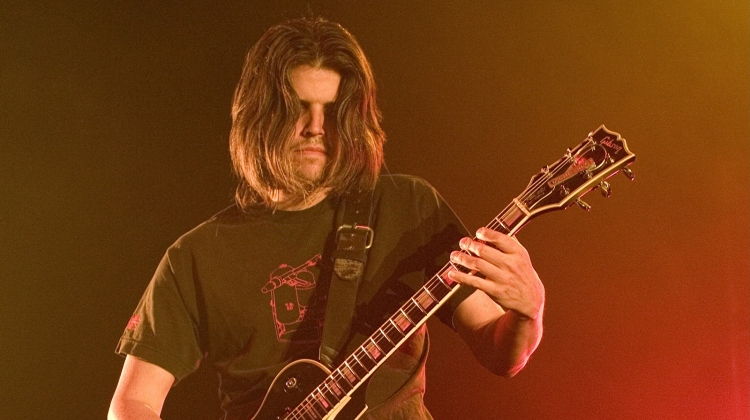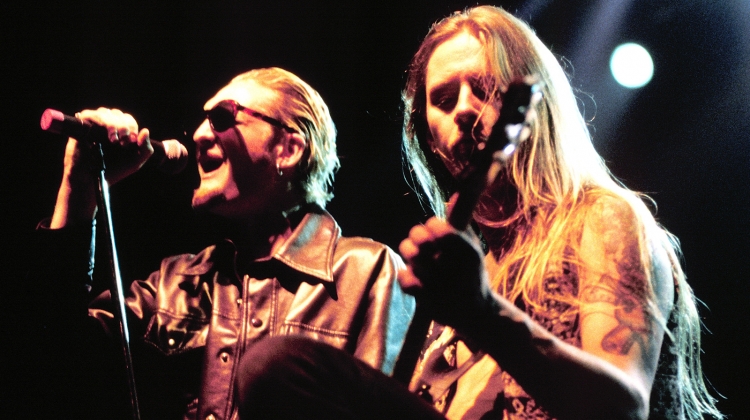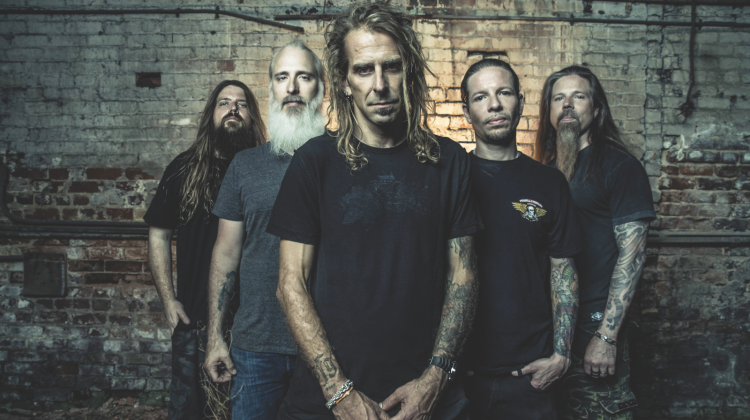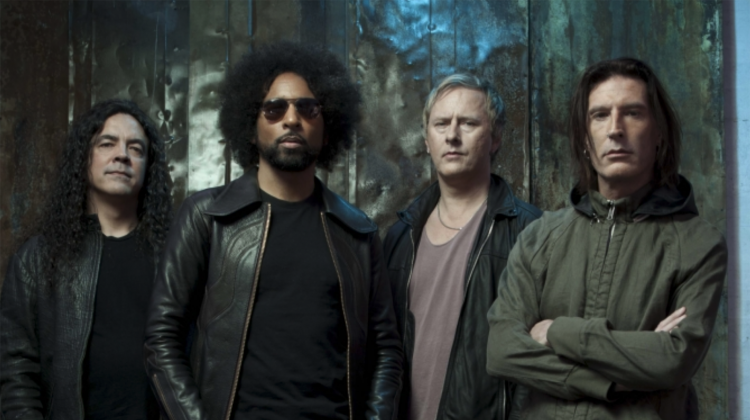For Tool fans, patience has always been an art. Five years elapsed between the release of 1996's Ænima and 2001's Lateralus, and the same delay preceded their fourth and most recent LP, 2006's 10,000 Days. In real time, the wait can be excruciating, but there's an upside to the glacial pace: Tool's albums are so sonically dense, so packed with obscure references, that it takes years to fully digest them. As of today, it's officially been a long-ass time since 10,000 Days, which makes this an ideal time to survey the most intriguing stories and details behind that modern classic.
1. No, the album title isn't some kind of future-snark prediction about how long it would take Tool to follow up their upcoming fifth LP. But multiple theories persist as to the real meaning.
In an interview with writer Jon Wiederhorn, Keenan pegged the title to the astrological and philosophical notion of the "Saturn return," a reference to the planet's orbit around the sun.
"That's the time in your 28th, 29th year when you are presented the opportunity to transform from whatever your hang-ups were before to let the light of knowledge and experience lighten your load, so to speak, and let go of old patterns and embrace a new life," he said. "It's kind of the story of Noah, and the belly of the whale [Noah built the Ark; Jonah was swallowed by the whale]. You sink or swim at that point. And a lot of people don't make it. Hendrix didn't, Janis Joplin didn't, John Bonham. Kurt Cobain didn't quite make it past his Saturn Return. For me, starting to recognize those patterns, it was very important to start constructing songs that chronicled that process, hoping that my gift back would be to share that path and hope that I could help somebody get past that spot."
A more pervasive — and poignant — theory is that "10,000 Days" nods to the length of time between Maynard James Keenan's mother being paralyzed from an aneurysm and stroke and her death three years before the album's release. On the the two-part epic "Wings for Marie," the frontman seems to reference his mother, a devout Christian, and the pain of watching her suffer. "A passionate spirit/Uncompromised/Boundless and open/A light in your eyes, then immobilized," he sings over a psychedelic guitar drone. On the chorus, he intones, "It was you who prayed for me/So what have I done to be a son to an angel?"
While Keenan has rarely cited his mother as the song's direct inspiration, he did mention her in the "Judith" music video commentary from A Perfect Circle's 2004 CD-DVD set, aMOTION. "The song itself is called 'Judith,' which is my mother's name," he said. "She was paralyzed very early on from an aneurysm, and it just strengthened her faith, which is fine, because she didn't really have anything else but her faith."
2. Cover artist Alex Grey created his trippy front image of intersecting faces, "The Net of Being," based on a "blazing vision of an infinite grid of Godheads during an ayahuasca journey." Guitarist Adam Jones, a key contributor to all the band's music videos, then worked with Grey on translating the painting into a 3D animation for their "Vicarious" clip.
"The four members of Tool are very art-based, concentrating on theories of sacred geometry where we could take any kind of presentation and break it down into its most fundamental, simplest element and then build it back up from that, no matter what the subject of the song was," Jones said in a video interview. "I kind of see the same thing in Alex's work."
In a separate interview, Grey — whose work previously graced the cover sleeve of Nirvana's In Utero and the inner booklet of Beastie Boys' Ill Communication — discussed the intense challenges of painting his intense "DMT visions."
3. At various points on the album, Danny Carey triggers eerie samples and weird percussion noises using his custom Synesthesia Mandala drums. (They were released to the public in May 2006, the month the album was released. Killer promotion!)
The album's engineer/mixer, Joe Barresi, has often recalled showing up to Tool's first album rehearsal and being dumbfounded by the amount of raw sound Carey produced with his tricked-out kit.
"When I first showed up to their rehearsal, I thought there were eight guys inside playing," he told Mix that year. "I was like, 'Who's playing percussion in there?' And it turns out that it's all Dan. He has Mandala electronic pads that his friend Vince De Franco designed for him. He plays the Mandala pads, and they trigger sounds that he has sampled himself. It sounds like he has eight limbs."
4. Tool always experiment in the studio, but they indulged at a new level during the 10,000 Days sessions — incorporating bizarre gear like a "pipe bomb microphone."
"It was a guitar pickup mounted to a piece of copper tubing, and it looked like a pipe bomb," Barresi told Mix. "I was using that inside of Maynard's megaphone." Elaborating to Louder Sound, he added, "Maynard and I spoke of recording his voice in weird ways, and that's where the pipe bomb mic came into being. It was a guitar pickup mounted onto a piece of pipe. It didn't work at all for vocals but ended up on a guitar solo and sounded wild."
Other weird recording tricks included Keenan singing into resonating snare drum heads and mic-ing up bassist Justin Chancellor's fingers.
5. When Jones needed some advice on how to achieve the perfect Talk Box effect on "Jambi," he called up a somewhat surprising — yet appropriate — consultant, the Eagles' guitarist Joe Walsh
"I always wanted to use a Talk Box — I love Joe Walsh — but I never wanted to use it for the sake of using it," Jones told Guitar World in 2006. "We wrote this song and I knew that it was the song where the Talk Box would work really well ... My friend who works for the Eagles' booking agent talked to Joe Walsh and gave him my number. A while later I got a message from Joe on my answering machine: [imitates Walsh] 'Adam Jones, this is the Talk Box fairy. Give me a call.' I called him and he was totally cool and gave me a lot of advice. I think that the Talk Box on [the Eagles'] 'Those Shoes' is really amazing, especially how the harmonies are in each speaker. I'm really happy with how the Talk Box came out on this record."
6. Tool jokingly referred to 10,000 Days as their "blues album" because of its grittier, sadder subject matter
"On our last few albums, there's been more of a metaphysical, attempt-to-open-your-third-eye kind of approach, having faith that people will find a way to expand their consciousness and wake up to the world that they live in," Keenan told Revolver in 2006. "For some reason, we felt like we could help 'em with that. And I think over the last few years, I've either gotten older — or become the grumpy guy who keeps your ball when it bounces in his yard — but I think I've lost a little faith watching the whole political thing."
In the same interview, he compared the resolve of college students protesting the Vietnam War — specifically the Kent State massacre of 1970 — with a more lackadaisical response to injustice in the Internet era. "It seems like nowadays, people sign a petition online or they send an email," he continued. "That's about as much as they can do, and it's a little depressing to me. So I've noticed that this album has a lot more sadness on it. We've been joking about it in a way, but this is kind of, like, our blues album. There's still a lot of hope in it, and there's still a lot of positive, fun, silly stuff. But if there's a theme to it, it'd be, 'Hey, you can lead a horse to water, but you can't make him drink. I have witnessed this first-hand — and therefore, you're on your own.'"
7. 10,000 Days, like most of Tool's music, feels like a perfect acid trip soundtrack. But Keenan actually designed the explosive, acerbic "The Pot" as a critique on frivolous drug use.
"That song Maynard kind of went with the [irresponsible] side, or the people who interpret drug influences the wrong way," Jones told BBC Radio in 2006.
"There's the whole idea behind the discipline of meditation or shamanistic rituals that has to do with getting to those spaces where you actually step out of your own body and you have other experiences ... trying to open up your Kundalini [energy], this intense years of training, and all of the sudden, people come along with LSD and bypass the whole discipline process," Keenan added. "I think that time most of those people took to do those things, you're kind of preparing yourself in a way so what you actually see you understand on some level. When you're a kid who just drops a tab of acid, if you have no frame of reference for the experience, it's kind of like spiritual theft in a way because you're not really coming back with anything to share. And then people use those transitions as a crutch and they don't ever really come back from them."
8. Despite the impossible-to-count time signatures and polyrhythmic madness, Keenan was most psyched about recapturing some of their straightforward heaviness on tracks like "Jambi" and "The Pot."
"I was kind of hoping the album would bring back some of the energy we expressed on our early records," he said around the album's release. "It was very difficult to get a groove going on some of 10,000 Days because everything was so complex and choppy and like running up an uneven set of stairs with a blindfold and a wooden leg. I wanted to do some of that because I really enjoy the challenge of a puzzle, and putting lyrics to those complex pieces. But I was also looking forward to doing something that would be like running down a set of stairs with my eyes closed and know that I'm gonna land on my feet."
9. Tool's studio pastimes included video game showdowns and screenings of a notorious R&B opera
"We played a lot of Guitar Hero — I remember that game coming out back then and I turned the guys onto it," Barresi told Louder Sound. "That was a good pastime in the lounge, as well as making anyone who came to the studio sit through R. Kelly's Trapped in the Closet DVD. Priceless entertainment."
10. Tool fans are so obsessive, they discovered that closing soundscape "Viginti Tres" and "Wings for Marie," when played back-to-back, equal the track length of "10,000 Days." And if you overdub the latter track on top of the aforementioned hybrid, there's an interesting synchronicity between the riffs and melodies — even though it's clearly just a fun coincidence. Right?
This mash-up became so popular among Tool fans that journalists started asking the band members about it during interviews.
"We can barely decide whether we're going to do a baseball cap or a beanie," Keenan told the A.V. Club in 2006. "You know what I mean? Now, granted, if you subscribe to the whole spiritual, energetic level, when you get into that weird, meditative state ... I'm trying to think of the word ... Sufis? I don't remember — the whirling dervishes. When you get into that weird state, at some point, your body clicks out, and you have a weird out-of-body experience, and so you can tap into those things unconsciously. So if people are reading into those kind of things that basically had nothing to do with us, that are just us clicking in a moment and being true to that whirling-dervish process of emoting with each other, some of that stuff just might naturally, accidentally come out. But it's not in any way a product of our design."
Jones, in his Guitar World interview, even recalled a fan messaging him on MySpace to explain her theory about how "Lateralus was written to [Mel Gibson's 2004 film] The Passion of the Christ."
"It's so amazing how it links up. I want to thank you for doing that,'" he recalled her saying. "I wrote her back and said, 'Cool. You figured it out.' Of course, we wrote that album way before The Passion of the Christ came out, but I loved how she tried to link our music to something else."











